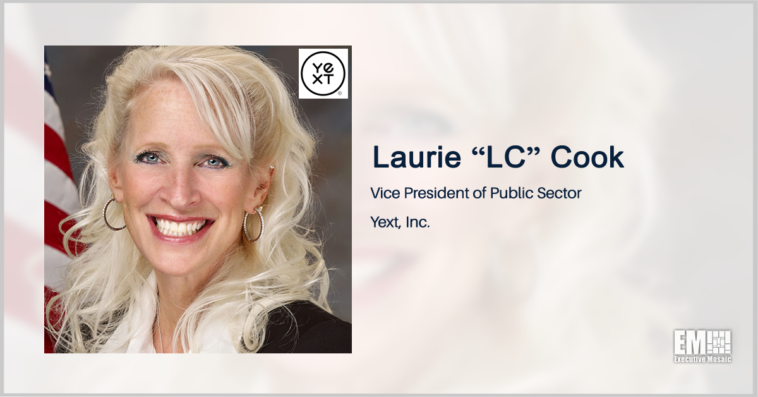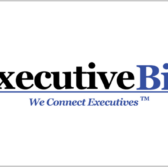LC Cook, vice president of public sector business for Yext, recently spoke with ExecutiveBiz regarding the importance of developing AI solutions for the company’s customers as well as the impact that other emerging technologies are making across the federal sector in the publication’s latest Executive Spotlight interview.
In addition, Cook also discussed the core values of Yext’s company culture, the challenges that federal agencies are facing to stay ahead of the curve technologically and how Yext can help with the hurdles of AI implementation and innovation.
“Innovation is no longer just lip service. There are real programs and government roles designed to drive improvements in the public sector. While the pandemic put severe pressure on government agencies, it also provided an opportunity for emerging technology adoption to accelerate.”
You can read the full Executive Spotlight interview with LC Cook below:
ExecutiveBiz: What are the core values that are important to your company’s culture? How has your team developed its workflow and ability to drive success in such a competitive market?
“Yext is all about enabling employees to deliver best in class AI solutions to its customers: from service delivery to customer success, all Yexters combine their talents to ensure our customers are meeting their AI goals. We do our best to be yex-traordinary.
When employees feel like they are part of something special, you see that reflected in their work. Communication and collaboration are key indicators of success: when these two concepts combine, ideas flourish!
As a global company with more than 1200 employees and 18 offices worldwide, Yext has earned several awards for “Best Place to Work” among a host of others. The core to our success has been to attract and retain top talent where everyone works towards a common goal. I’m proud to be a part of such an inclusive company that works hard to recognize the contributions of its employees.
ExecutiveBiz: Congrats on recently joining the company and/or assuming your new role! Why did you want to join the company and what were the attributes of its mission that attracted you to the role? What do you hope to accomplish with the company?
“As the daughter of a United States Marine, it has always been a core value of mine to give back to those who serve us: Public servants in both the civilian government as well as active duty and veterans. I was in search of a company that had a solution that would make the mission of connecting with the public easier for the government.
Think about it, the government exists to serve the public. Period. Finding technology that can assist with this mission was paramount. Early in 2018, the government adopted the Integrated Digital Experience Act with the goal of improving the way the agencies interact with the public. I saw many positive strides, but there was clearly much more that could be done.
I see Yext as the leader in AI Search which enables clients (in my case, the public) to access a website, ask questions in natural language and receive rich and accurate answers back–without needing to click on additional blue links to oftentimes unrelated content.
I came to Yext to bring the experience of intelligent search to federal and state agencies and to give these governing bodies a way to bring true and authoritative information to the public.”
ExecutiveBiz: With federal agencies working to implement the latest trends in technology such as AI, 5G, cloud and many others, what are your thoughts on the success and challenges that government agencies are dealing with to stay ahead of innovation to establish the U.S. as THE global leader?
As new technology emerges, it’s not uncommon to see a lag in adoption within the Federal space. Sometimes this is due to a shroud of uncertainty about what a technology is or does.
For example, some in the government viewed AI as a product and not as a type of computer science. Grasping the concept of multiple algorithms to execute a series of tasks was a challenge. Now, more than ever, there is a true handshake between the public and private sectors which is accelerating the government’s appetite for emerging technologies.
The Feds are taking cues from what works for large businesses and applying those ideas to its mission(s). In my opinion, the larger challenge with staying ahead of innovation is the government’s ability to interact with millions of people per day–to slow the operation of serving the public to innovate means something has to give.
Will that be slower response times? Will it be delayed benefits? Finding that balance of incorporating new and bold solutions while keeping the machine running is a delicate dance.”
ExecutiveBiz: With artificial intelligence and machine learning impacting most industries and the U.S. military dramatically as we move forward, what has impressed you the most about the technology’s capabilities to improve decision making across the federal sector and all areas? In addition, how can AI be used to address some of the biggest challenges you see in your industry?
“The Government has a responsibility to improve the way they interact with the public. The new PMA and the recent Executive Order on improving customer experience supports this.
Technology is the accelerant, the enabler and the healer for better citizen support. AI Search, for example, is being successfully leveraged throughout the private sector. Banks, restaurants, retail, healthcare are all using AI Search to better serve consumers. Why shouldn’t federal agencies tackle their ‘customers’ the same way?
As consumers, we expect fast answers to natural language questions. When we Google ‘best Italian restaurants near me’, we get a list of 4+ star suggestions in our area. This is because the algorithm understands the connection between ‘best’ + ‘Italian’ + ‘restaurants’ + ‘Near me’, and not just individual keywords. We’ve been trained to expect this type of answer as consumers.
However, when we attempt to find information on government websites, we get part of the answer–a blue link to a keyword we searched. But that’s not the full answer we sought to begin with. Getting a keyword response is like getting a car with no engine. We asked for a vehicle, but we can’t actually drive it.
With Yext, we leverage a knowledge-graph that is an expansive database that connects entities within an organization that is built specifically for search. Our multi-algorithm approach allows for a question asked in natural language to return just the answer–the right answer.
Apply this concept to the thousands of government websites. Imagine being able to go to the SBA website and asking ‘how do I get a small business loan’ and having those answers surfaced in an easy to understand snippet.
Today that question will lead you to congressional testimony. The bottom line: the government is the greatest source of true information; but the data resides in so many disparate systems that finding an answer becomes challenging, if not impossible.
Data is recognized today as an asset. I ask you, ‘how important is it for government agencies to have access to data–ALL data?’. When AI is employed, connecting the data-dots becomes intuitive and allows for faster, more accurate information to be delivered to the public.”
ExecutiveBiz: In recent years, what are some of the biggest improvements you’ve seen in the way we talk and think about innovation across the federal sector since the rise of cybersecurity, AI/ML, 5G and other emerging technologies?
“Innovation is no longer just lip service. There are real programs and government roles designed to drive improvements in the public sector. While the pandemic put severe pressure on government agencies, it also provided an opportunity for emerging technology adoption to accelerate.
We began to see that there’s a better way to get answers into the hands of the public. A great example of this is AIDAN, the US Department of Education’s (FSA) virtual assistant that uses advanced technology, including AI and Machine Learning. FSA recognized that most people prefer to self-serve and through AIDAN, contact center calls were significantly reduced.
We know that from a study the IRS did, that in-person visits and support calls cost about $40-$60 dollars per incident; but self service portals can give taxpayers the same information faster for about $.22 per incident.
Think about that—those interactions don’t just translate to saved dollars, it translates to happier constituents and higher public trust. Never before has there been a more important time than now to provide fast, accurate and timely information to the public in a way that’s easily accessible.”
ExecutiveBiz: As the federal health sector continues to be heavily influenced by IT modernization and a wide range of other initiatives to improve its networks, platforms and data, what are the greatest improvements that are being developed in federal health and what else needs to be addressed?
“What does modernization mean in HC? It’s moving from a reactive platform to a proactive platform. Instead of waiting for something to happen, emerging technologies (like AI Search) allows medical professionals to be prescriptive, predictive and to leverage data to make better, faster decisions that impact patient outcomes.
If a healthcare worker can make a proactive decision that leads to a positive outcome the natural result is a better patient experience. Think about healthcare from two lenses: Military/Veteran Health and Population Health. The commonality for both is how platforms and IT enable access.
The pieces of the puzzle in the patient journey and the patient experience are influenced by access and data. Consider the mayhem that ensued throughout the pandemic. There was so much information from disparate sources AND miss-information swirling around that no one knew what was true. I’d argue in many ways we still don’t. This became a crisis of confidence, a lack of trust.
The most important aspect of HC is the need for collaboration. If the caregiver has access to more information, they can make better decisions that impact a patient’s outcome. The need to collaborate around data is critical to building a trusted network of care. The shift to Electronic Medical Records is a great start!
The number of systems that hold PHI is significant (patient information, lab results…), but the systems don’t always play well together. What if governmental health agencies developed a knowledge graph, a fact based platform, that takes all of the science and patient information and allows the consumer/patient/constituent to get an answer and use that answer to take the next best step?
This becomes a game changer in the patient journey–with the public being at the center of the wheel. The biggest difference between the public sector and private sector is the absence of a revenue bias. Private sector: how do we get more people to our hospital? In the public sector: how do we serve the patient better? If we can shift to putting the patient first, the rest follows.”





